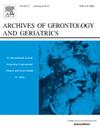开发、验证和临床应用的风险预测模型,以确定老年痴呆妇女主动姑息治疗
IF 3.5
3区 医学
Q2 GERIATRICS & GERONTOLOGY
引用次数: 0
摘要
准确估计老年痴呆妇女一年死亡风险可以为临床决策提供信息,促进及时的高级护理计划,并优化姑息治疗的提供。本研究旨在利用具有全国代表性的澳大利亚队列,开发、验证和评估该人群一年全因死亡率预测模型的临床实用性。方法:这项预后研究利用了1921-26年具有全国代表性的、以人口为基础的澳大利亚妇女健康纵向研究(ALSWH)的队列数据,以及相关的国家和州行政健康记录。通过系统审查和专家咨询确定候选预测因子,然后使用数据驱动的统计方法进行改进。建立并验证了多变量二元逻辑回归模型来预测一年的全因死亡率。结果纳入1576例老年痴呆女性患者(平均年龄72.6±1.5岁)。该模型具有良好的判别性(AUC: 75.1%, 95% CI: 72.7% - 77.5%)和良好的校准性(斜率= 1.00,95% CI: 0.87-1.13;截距= 0.00,95% CI: 0.11 - 0.11)。使用10倍交叉验证和1000次自举迭代的模型验证显示其预测性能的最小乐观度,AUC乐观度分别为0.0047和0.0042。决策曲线分析表明,净收益在概率阈值范围从0.24到0.88之间,支持该模型在指导姑息治疗决策方面的临床效用。结论:该预测模型结合了现成的预测因子,在识别老年痴呆患者一年死亡率高的风险方面表现出令人信服的性能和临床实用性。该模型有可能促进及时的姑息治疗干预,并可通过基于网络的计算器公开获取。需要在不同人群和医疗环境中进行进一步的外部验证,以确认其普遍性。本文章由计算机程序翻译,如有差异,请以英文原文为准。
Development, validation, and clinical utility of a risk prediction model to identify older women with dementia for proactive palliative care
Background
Accurately estimating one-year mortality risk in older women with dementia can inform clinical decision-making, facilitate timely advanced care planning, and optimise palliative care delivery. This study aimed to develop, validate, and assess the clinical utility of a prediction model for one-year all-cause mortality in this population using a nationally representative Australian cohort.
Methods
This prognostic study utilised data from the 1921–26 cohort of the nationally representative, population-based Australian Longitudinal Study on Women's Health (ALSWH) and linked national and state-based administrative health records. Candidate predictors were identified through a systematic review and expert consultation, then refined using a data-driven statistical approach. A multivariable binary logistic regression model was developed and validated to predict one-year all-cause mortality.
Results
The analysis included 1576 older women with dementia (mean age, 72.6 ± 1.5 years). The model demonstrated good discrimination (AUC: 75.1 %, 95 % CI: 72.7 %–77.5 %) and excellent calibration (slope = 1.00, 95 % CI: 0.87–1.13; intercept = 0.00, 95 % CI: 0.11 – 0.11). Model validation using both 10-fold cross-validation and 1000 bootstrap iterations showed minimal optimism in its predictive performance, with AUC optimism of 0.0047 and 0.0042, respectively. Decision curve analysis indicated a net benefit across probability thresholds from 0.24 to 0.88, supporting the model's clinical utility for guiding palliative care decisions.
Conclusion
This prediction model, incorporating readily available predictors, demonstrated compelling performance and clinical utility for identifying older women with dementia at high risk of one-year mortality. The model has the potential to facilitate timely palliative care interventions and is publicly accessible via a web-based calculator. Further external validation in diverse populations and healthcare settings is warranted to confirm its generalisability.
求助全文
通过发布文献求助,成功后即可免费获取论文全文。
去求助
来源期刊
CiteScore
7.30
自引率
5.00%
发文量
198
审稿时长
16 days
期刊介绍:
Archives of Gerontology and Geriatrics provides a medium for the publication of papers from the fields of experimental gerontology and clinical and social geriatrics. The principal aim of the journal is to facilitate the exchange of information between specialists in these three fields of gerontological research. Experimental papers dealing with the basic mechanisms of aging at molecular, cellular, tissue or organ levels will be published.
Clinical papers will be accepted if they provide sufficiently new information or are of fundamental importance for the knowledge of human aging. Purely descriptive clinical papers will be accepted only if the results permit further interpretation. Papers dealing with anti-aging pharmacological preparations in humans are welcome. Papers on the social aspects of geriatrics will be accepted if they are of general interest regarding the epidemiology of aging and the efficiency and working methods of the social organizations for the health care of the elderly.

 求助内容:
求助内容: 应助结果提醒方式:
应助结果提醒方式:


